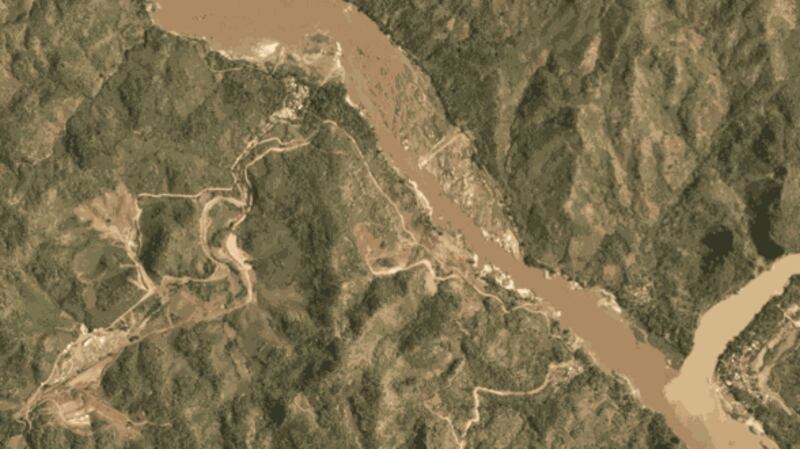A Thai dam developer has begun clearing land for a large-scale Mekong River dam near the ancient Lao capital Luang Prabang before signing a hydropower sale pact required for approval, raising concerns from downstream communities already hit hard by Laos’ aggressive damming of the vital waterway.
The intergovernmental group that manages Mekong River dam construction says the rules allow Laos to build roads and a camp to house workers – seen in satellite images and confirmed by Lao officials -- before formal approval of the dam.
Critics say the head start on forest clearing shows that the Mekong River Commission (MRC) – which grants Thailand, Laos, Cambodia and Vietnam the right to review dam projects for cross-border impacts – is being treated as a mere formality by Vientiane and its Thai partners.
Laos operates two dams on the mainstream Mekong and is in various stages of planning or building nine more, damming a waterway that provides fish, water and fertilizer for 60 million Southeast Asians and already has 11 dams upstream in China.
Part of the country’s ambitious but controversial strategy to position itself as the “Battery of Southeast Asia,” the 1,460 MW Luangprabang Mekong dam will displace 581 families or 2,285 people and will affect 20 villages. Construction is scheduled to begin this year and finish in 2027.

Satellite images of the proposed dam site observed by RFA on April 28 and July 14 revealed that construction on the access road to the dam had progressed on the northern side of the Mekong through a forested area, with what appears to be several buildings appearing on the south side.
The flurry of clearing and building comes as the Lao government is negotiating a Power Purchase Agreement (PPA) with Thailand and Vietnam, the buyers of the hydropower.
The PPA is a requirement of the MRC consultation process, but the commission does not have veto power over members’ dam plans.
“I think the Lao government doesn’t care about the world or the affected community,” Suwit Kulapwong, the coordinator of the Network of People in the Lower Mekong Region-Esan told RFA’s Lao Service.
“They believe that all processes like the prior consultation will pass and they will not change their minds on whether to build these dams or not,” he said. The network represents people from Thailand that will be affected by the dam.
Supporting infrastructure is allowed
An official of the Thai National Mekong Committee (TNMC), however, told RFA that Laos is within its rights to build the dam’s supporting infrastructure prior to formal approval.
“The Lao government can build whatever it wants without MRC involvement,” the TNMC official told RFA, speaking on condition of anonymity to discuss the issue freely.
“Though it is interesting that construction on the road and the camp has begun, even though the PPA hasn’t been signed,” the official said.
An official of Laos’ Energy and Mines Ministry on Friday confirmed the construction of infrastructure began in April and will be completed soon.
“We’re only building a road and a camp. As soon as the power purchase agreement is finalized, we will begin construction on the dam,” said the energy official, who added that local authorities will begin relocating villagers once the PPA is approved.
The Luangprabang Mekong dam is 15 miles (25 km) upstream on the Mekong from the city of Luang Prabang, a 14th-16th century royal capital and Buddhist Center that is home to 47,000 people and Laos' main tourist attraction.
“The Luangprabang dam developer should pay attention to the fact that the dam is close to the world heritage city of Luang Prabang,” said Somkiat Pachumwong, the secretary of Thailand’s Natural Water Resouces Office said Wednesday at a meeting in Bangkok to discuss drought in the Mekong region.
“The [Lao] government should be more cautious about the Luangprabang dam that it has been about the Xayaburi dam, especially considering the dam’s safety,” he said, adding that Laos should also minimize impacts and ensure free flow of water, sediment and fish.
Laos’ ‘internal affairs and sovereignty’
The Xayaburi dam was the first large-scale Mekong river dam to be completed. It began operations in October 2019, but critics say that its impact assessment greatly underestimated the scale of its impact on the region.
In February a Thai citizens group said the Xayaburi had caused extensive damage to fisheries and dramatic changes to an ecosystem that sustains millions of farming and fishing livelihoods.
Pianporn Deetes of International Rivers told RFA that Laos’ dams on the Mekong and elsewhere were not necessary.
“Mekong dams are not necessary and now we have a good opportunity to develop energy from other sources,” she said, and noted that the lockdown of the economy to fight coronavirus had slashed Thailand’s energy consumption for now.
In a comment on Facebook, a Lao government official denounced critics of Lao’s central economic development strategy.
“NGOs, environmentalists and human rights organizations that are demanding that Laos stop building dams cannot interfere in the internal affairs and sovereignty of Laos,” wrote Vice Minister of Science and Technology Souli-oudong Soundala.
The Luangprabang dam is a joint venture between Petro Vietnam Power Corporation, Ch. Karnchang and the Lao government.
Prior consultation for the sixth of nine planned mainstream Mekong dams inside Laos, Sanakham dam, began this week with an MRC member online meeting Thursday,
Laos has built dozens of hydropower dams on the Mekong and its tributaries, with ultimate plans for about scores more hoping to export the electricity they generate to other countries in the region. It is preparing to build scores more dams in the years ahead.
Though the Lao government sees power generation as a way to boost the country’s economy, the projects are controversial because of their environmental impact, displacement of villagers without adequate compensation, and questionable financial and power demand arrangements.
Reported by RFA’s Lao Service. Translated by Max Avary. Written in English by Eugene Whong.
